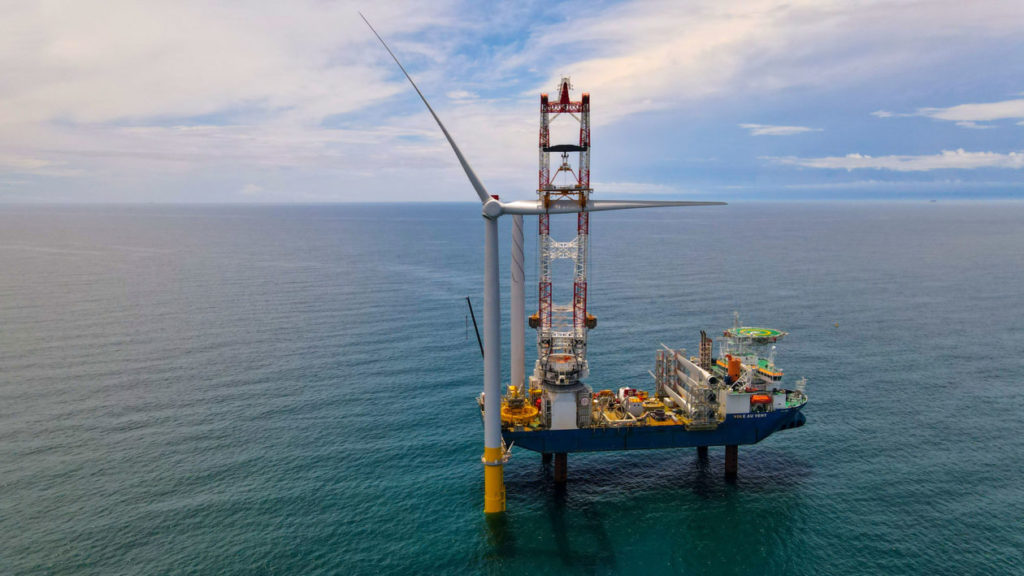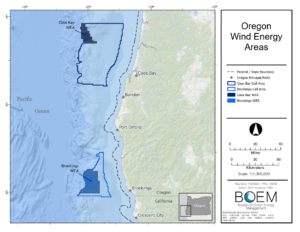
By ALEX BAUMHARDT/Oregon Capital Chronicle
A coalition of independent fishing boat operators, seafood companies and industry groups is calling on Gov. Tina Kotek to ask the federal government to stop a planned auction for floating wind energy projects off the Oregon Coast.
In a letter to Kotek last week, the more than 100 signatories said she should stop the U.S. Bureau of Ocean Energy Management from moving forward with its plan to auction offshore wind site leases until the state has finalized its own roadmap for offshore wind development.
That roadmap is part of House Bill 4080, which was signed by Kotek last week. It will create state policies on offshore wind energy development that include community input and labor standards. The roadmap must be completed by September 2025, according to the legislation.
“We’re saying no auction until the roadmap is complete,” said Heather Mann, executive director of the Newport-based Midwater Trawlers Cooperative, which signed the letter.
The letter noted that developing wind power off Oregon’s coast is an untested idea.
“Offshore floating wind energy does not currently exist anywhere in the world in waters deeper than 300 meters or at the scale being contemplated for the West Coast,” the letter said. “In addition to the roadmap, Oregon would benefit significantly by learning from projects that are already moving forward, such as those on the East Coast and in California.”
Other signatories include more than 80 independent fishing vessel operators and nearly three dozen coastal businesses and business associations, including the Columbia River Crab Fishermen’s Association and West Coast Seafood Processors. Coalition members fear the floating offshore wind turbines would disrupt marine ecosystems and Oregon’s commercial fishing industry, with about $200 million in annual revenue, according to the Oregon Employment Department.
“The roadmap is the only way to ensure a transparent and equitable approach to considering offshore wind energy,” the letter said.
Five Oregon and California tribes also oppose the federal wind power plan. In November, the Tribal Council of the Confederated Tribes of the Coos, Lower Umpqua and Siuslaw Indians passed a resolution opposing offshore wind energy development, in part because federal officials had failed to respond to their concerns.
Projects moving forward

The Bureau of Ocean Energy Management has auctioned five areas off the California coast to develop floating wind energy projects, and it approved six projects on the East Coast. They’re part of the Biden administration’s plan to build up 15 gigawatts of offshore wind energy capacity by 2035, with a total of 30 gigawatts deployed by 2030.
The two wind energy areas being considered for development off Oregon’s southern coast would add 2.4 gigawatts of clean power – enough to power about 830,000 homes – with installations covering more than 195,000 acres in total. One site, near Coos Bay, would span about 61,200 acres and be located more than 30 miles from shore, while the other site, near Brookings, would cover about 133,808 acres and float about 20 miles from shore.
Last year, the Bureau of Ocean Energy and Management gave Oregonians several months to comment on the agency’s plans, and nearly 1,000 people weighed in. Agency officials also visited Brookings, Gold Beach and Coos Bay last fall to talk to fishing groups, officials and residents about installing wind turbines offshore.
The agency recently denied a request by Oregon’s congressional members to extend a 30-day public comment period on the planning and the environmental assessment that needs to take place this summer.
“Fishermen are hoping that a more forceful response from Gov. Kotek will change the tide,” the coalition said in a news release.



I have yet to see one iota of actual scientific evidence that offshore wind energy will harm the fishing industry or sea life. Yet we have non-stop and extremely vague, nebulous objections to wind energy from numerous special interest groups. These folks want to fiddle while the Earth burns from climate change.
The Earth’s climate has been in a constant cyclical state of change since day one. That’s 4 billion years. Yes, we are in a period of global warming, and no, the Earth is not burning. The question is how much human activity has contributed to this global warming. I have seen studies that estimate the Earths average temperature has risen 1 degree Celsius since the dawn of the Industrial Revolution 250 years ago.
Power generation has two important components. Energy, and capacity. All generating resources produce energy, but only resources that can follow a load provide capacity. A dam with a big reservoir behind it can ramp up and down to follow a load. A coal plant, a combustion turbine or a nuclear plant can all serve to follow a load. Wind power however is intermittent by nature and can’t be used to follow a load. Wind power produces zero capacity and needs to be “shaped”. Shaping wind power requires that the control area operator use other resources to provide the capacity that wind power cannot. Currently, the Bonneville Power Administration uses the Federal Columbia River Power System to provide wind shaping capacity, and they struggle to do it. As global climate change impacts the snow fall, snow melt, and ultimately, when and how much water flows through those dams, we may find ourselves without the capacity to shape 2.4 gigawatts of intermittent energy. An increase in extreme weather demands more capacity not more energy.
Wind energy in the ocean off the Oregon Coast makes no sense. All of the communities are preparing for the big earthquake and tsunami that follows. Why spend millions if not billions on a program that is iffy to begin with and would be wiped out by the earthquake/tsunami. I do not want my tax money subsidizing these types of projects.